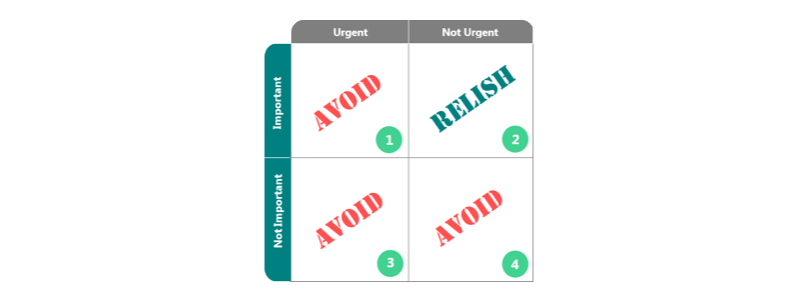Ever wonder why your long-term high-value projects (the “wouldn’t it be greats?”) get left on the back-burner? Here’s why, and here’s how to make them happen.
All projects — both personal and professional — can be classified in the Important/Urgent matrix above. This matrix, outlined by Stephen Covey in The 7 Habits of Highly Effective People, lives subconsciously in our brains. As soon as an item (project, problem, stimuli) pops up, we immediately put it in one of these quadrants: Important-Urgent, Important-Not Urgent, Not Important-Urgent, Not Important-Not Urgent.
Sounds pretty good, right? We’re prioritizing what needs to get done without even thinking about it! The problem is, we tend to spend time in the least rewarding quadrants.
Important – Urgent (aka Crises)
Of course, important-urgent items need to be addressed immediately. They’re crises. A valuable customer threatens to leave. Your computer crashes during a critical presentation. Your house is on fire. There’s no denying that you need to deal with these issues right away.
But when you constantly live or work in the crisis quadrant, you’re continually putting out fires. Your day is dictated by what needs to get done, rather than what should get done. Everything is reactive because there’s no time to plan.
The key to staying out of Quadrant 1 is to focus on items in Quadrant 2. The more energy you put towards managing your long-term goals, the less likely you are to end up with a crisis. For instance, if you’re working towards the goal of 100% customer satisfaction, it’s less likely that a valuable customer will want to leave.
(Note: Risk-lovers and chaos-connoisseurs tend to enjoy Quadrant 1.)
Important – Not Urgent (aka Goals)
Important-not urgent items are the most valuable. Unfortunately, they’re easiest to avoid. They’re the long-term goals, strategic plans, and relationships. You want to lose weight. You want to change careers. You want to increase your employees’ happiness. There’s no immediately urgency to these items, so you can put them off.
Problem is, when you put off Quadrant 2 items, they can grow over time into Quadrant 1 issues. Your weight lands you in the hospital. Your dissatisfied employees all quit. Now you’re forced to deal with the issues, but you don’t necessarily have the time or resources. Sometimes, the damage has already been done.
So, relish the items in Quadrant 2. What do you want to achieve? What have you been avoiding? What were your New Years resolutions? Make a plan to execute them. Ask someone to hold you accountable. To achieve your goals, you have to live in Quadrant 2.
(Note: Leaders and strategic thinkers tend to enjoy Quadrant 2.)
Not Important – Urgent (aka Interruptions)
Not important-urgent items are interruptions and distractions. They grab your attention, but they aren’t worth it. The phone rings. There’s an unnecessary meeting in 5 minutes. Your favorite TV show is about to start. These items feel pressing, but they’re not valuable.
To avoid Quadrant 3, either create a new system (i.e. keep your phone ringer is off), or reschedule (“Let’s discuss this on Monday”) or reject and explain (“I’m sorry, I won’t be able to attend”). Reducing interruptions will leave more time and energy for Quadrant 2.
(Note: Distraction-lovers and channel-changers tend to enjoy Quadrant 3.)
Not Important – Not Urgent (aka Waste)
Not important-not urgent items are the worst of all. They just don’t need to be done. Sure, the files from last year could be color-coded. Sure, a promotional email just came in. Sure, you’re curious about the land speed of a cheetah. But you don’t need to spend time addressing these items.
Why is it so hard to avoid Quadrant 4? Because humans simply can’t be productive 100% of the time. Our brains need a break. So we look for ways to zone out or to passively observe until our brains are refreshed and ready to work again.
My suggestion: if you need a break, take a break worth taking. Stand up and stretch. Walk around the block. Call your grandma. Just don’t fall into an internet clickhole.
(Note: Procrastinators and busy-workers tend to enjoy Quadrant 4.)
———————
Action items:
〉 Using pencil and paper, make an Important/Urgent matrix.
〉 Fill in the quadrants with tasks and stimuli from your life.
〉 Assess which quadrant(s) you spend the most time in.
〉 Make a plan for focusing your time and energy on Quadrant 2.

